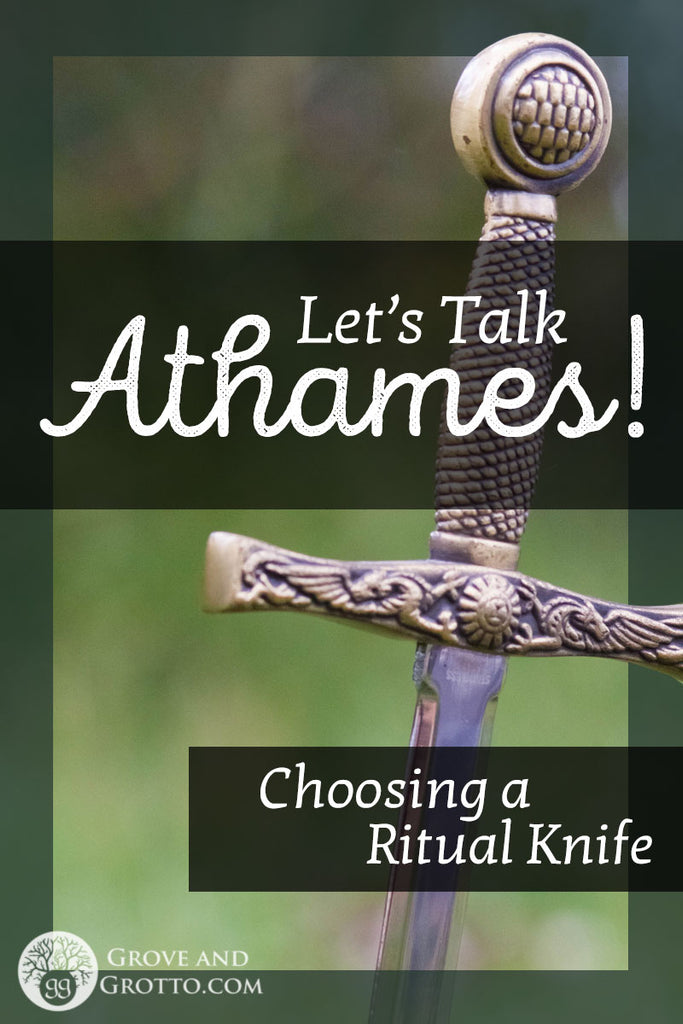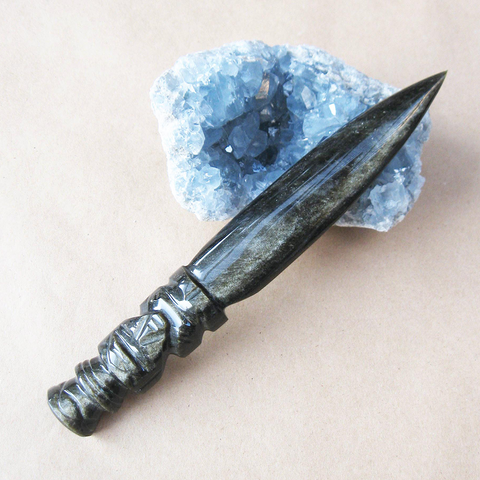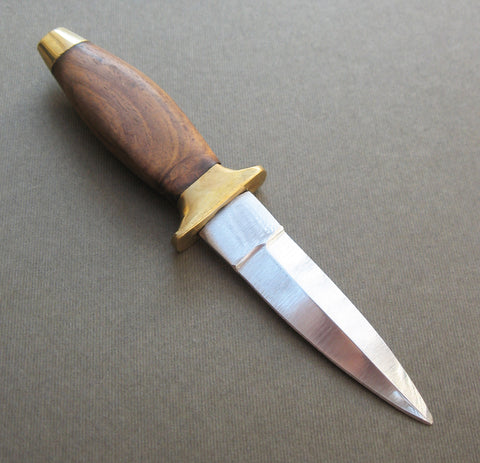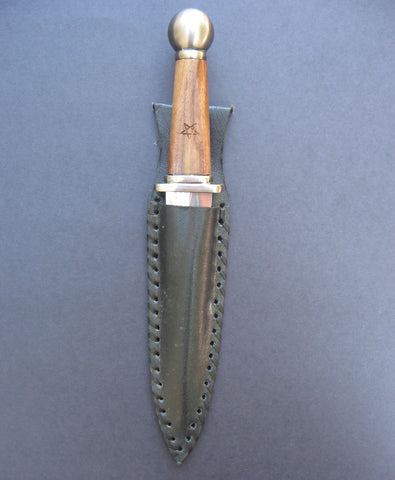
One of the most important Witch’s helpers is the athame, or ritual knife. The athame is the elemental tool of Air or of Fire, depending on your tradition. It is generally not used to cut physical objects, but to direct energy and draw boundaries.
Most closely associated with Wiccan practice, the word “athame” is of ambiguous origin. (Read: Gerald Gardner probably made it up.) But you don’t have to be Wiccan to use an athame. Magickal practitioners of many paths have adopted the term to distinguish ritual knives from their mundane cousins.
In this article, we’ll discuss some of the most common questions about choosing an athame for your personal craft.
Size and shape
Ritual knives come in all different shapes and sizes: Long and slender, fat and wedge-shaped, curved and straight, tiny and imposing. Finding the right fit for you is the first consideration in choosing an athame for your toolkit.
When it comes to using your athame for magick, size doesn’t matter. Size is just a condition of the physical plane, and a skillfully wielded tool of any size can be effective on the astral and energetic levels.
Still, you want an athame that fits comfortably in your hand and “feels” right. Size is a part of that feeling. When you wrap your fingers around the handle, they shouldn’t cramp or slip off. It’s also a good idea to match the look and feel of your athame to the type of energy you plan to project. Is your athame wise, incisive, Airy? Then a slender, lightweight blade and handle is your friend. If your energy leans toward the forceful and uncompromising, try a thicker, shorter knife.
You’ll also want to consider where the athame will be used. If your altar setup is small, or if you plan to carry the knife discreetly with you, then smaller is obviously better. Those who do large public rituals or share tools within a coven will probably want something that can be seen from at least a few meters’ distance.
Finally, you want the design of your athame to be on scale with the rest of your ritual tools. They’re going to work together and—though they don’t need to “match”—some type of harmony is required. Dunking a tiny letter opener into a giant chalice is kind of underwhelming, if you know what I mean.
While we’re on the subject, we’ve got to talk about the um, anatomically suggestive “bollock” athames. The athame is usually considered to be a masculine tool, and these phallic designs serve as a wonderful visual reminder of masculine power. Still, be aware that if you wield one in public, some observers will snigger at your well-hung ritual gear.
Material

The possibilities are enormous—athames come in a wide range of metals and other materials. The most traditional combination is iron (or steel) with a wooden handle. This pairing is a classic for a good reason: Mighty iron (the metal of Mars) is encased in the organic, gently conductive energy of wood.
When buying a metal athame, pay attention to the construction of the blade and handle. A knife blade that is forged in one piece, rather than glued or welded together, will resist breakage and conduct energy more smoothly. The best quality knives have a tang (base of the blade) that extends most or all the way through the handle.
Shopping at craft markets or online may yield up athames made of wood, bone or gemstone. Faery witches often avoid iron-containing metals to avoid offending the Fae. And Shamanic practitioners may choose the bone of a special animal for this purpose. Resin, rubber, and plastic parts aren't ideal for a ritual tool, but they can make large and dramatic athames much more affordable.
Consider both your beliefs and the energetic properties of each material when selecting an athame. A store-bought blade can be embellished with crystals, charms, paint, or other add-ons to make it uniquely yours.
Blade
A double-edged blade is prescribed for Wiccan practice by Gardner, and is certainly the most popular form of athame. Since you can cut in either direction, it’s not necessary to rotate a double-edge blade as much when drawing complex shapes, like sigils. An athame is also the proverbial “double-edged sword”—a tool of neutral power that can be used to do good or harm.
There’s sometimes a debate about whether a ritual knife ought to be physically sharp. Personally, I say, “yes.” The best symbol for a sharp knife is, after all, a sharp knife. The energy directed from an athame should be precise and potent. If the user is aware that the blade is dull, it can’t help but have a subliminal impact on the quality of the energy. (If the athame you bought isn't as sharp as you'd like, a household knife sharpener can whip it into shape, fast.)
Whatever its ethereal effects, a sharp blade comes with real physical hazards. There are many good reasons to employ a ritual blade that’s not razor-sharp. If you’re working in a small space with others, if you’re especially clumsy, or if you do ritual with or around children, maybe don’t choose an athame that’d be the envy of a sushi chef. Remember, it’s all a magickal good time until someone gets filleted.
There’s also the limitations of the material—an all-wood athame will never have a cutting edge as sharp as metal. But it can still get the job done if your visualization skills are strong.
Legal issues
Whatever athame you choose, it’s a good idea to know its legal status in the state or country you live in. There may be age or size restrictions on knife purchases. Double-edged knives of any size are forbidden in many jurisdictions. There’s no guarantee that you won’t be arrested, fined, or have the knife confiscated if you get busted with it.
In my home state of Texas, most athames I sell are legal to own but illegal to carry in public. Don’t ignore local knife laws when bringing your athame to public gatherings. Though people are growing more tolerant, there are still some authorities who are just looking for reasons to disrupt peaceful Pagan gatherings. The argument, “But it’s my religion!” is likely to be met with “Tell it to the judge.” Consider consecrating a legal stand-in athame for public use.
I hope this article helps you with your knife shoppin'! Please check out our current selection of athames, or read more articles in the archive.



